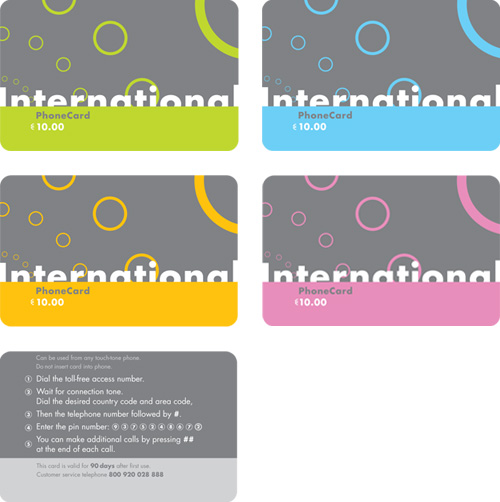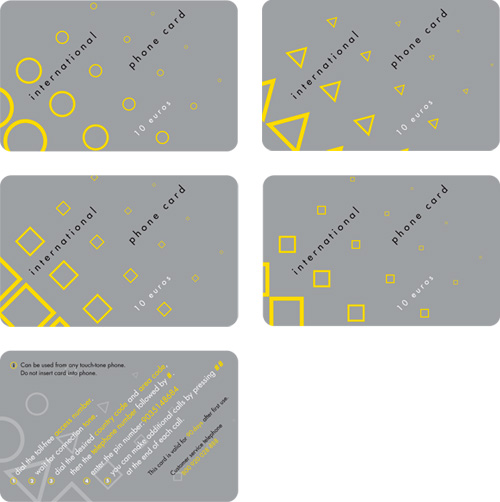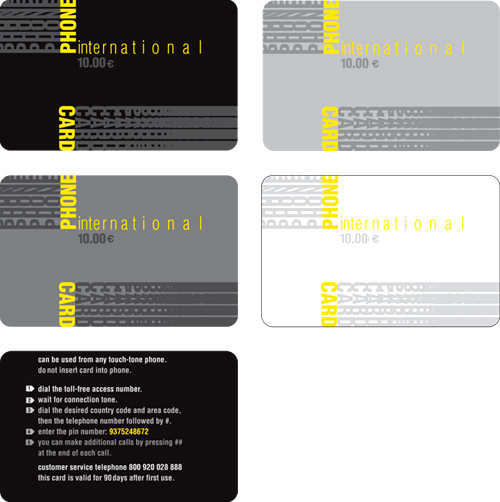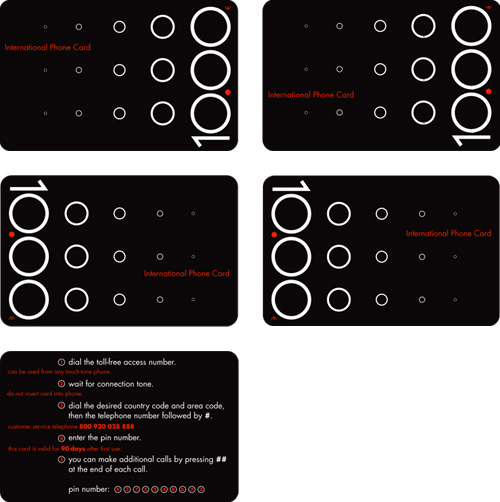VCD Phone Home
April 30, 2009 at 7:34 pm · Filed under Identity / Systems, Industrial / Product, Type / Fonts

phone card set; series of four fronts (top); one back (bottom); 3.4in. x 2.125in. each / 2002
It seems that there are (or were) two major markets for long distance phone cards.
One is (or was, I’m guessing) Europe, where long distance on a phone plan, in comparison to U.S. phone plans, would span relatively little actual distance, and wanderlust runs rampant. In the days before near-ubiquitous mobile phone proliferation, I imagine there was much use for a card that would get you in touch with another country, or back in touch with home when you got there, without costly service charges from one’s domestic carrier. Even with a mobile, a roamer could easily outbound their domestic plan with a quick clip on the TGV.
The other market I’ve seen for such cards is quite different, and still as vibrant as ever. Having lived in New York for several years now, I’ve been confronted by gangs of international phone cards, shouting at me from behind so many raised bodega counters, each garish explosion of bling and atrocious typography shouting louder than the next, like a traffic jam in the South Bronx. This city, it seems, has the requisite population of aliens without the means for a long distance plan (or even a phone, in many cases), needing to reach out and touch their homelands, such that the cacophony of prepaid, foil-stamped minutes is warranted.
But, having lived in Seattle almost my entire life as of 2002, with its relatively scant collection of migrant workers (or Europeans), I’m not sure I’d ever even seen a phone card until I designed my own. This project, another in the Advanced Typography class of the Visual Communication Design (VCD) program at the University of Washington, was the novel creation of our professor (fresh from an extended European vacation). Here, we were to design a series (or multiple series) of ten-Euro calling cards…
Of course, being in a proper design program, my cards didn’t have any of that garish metallic noise, but I did try to convey, in abstract terms, traveling voices.
I thought of listening in on what a phone call from a traveler might be like. Would it be colorful and loud, as from a pétit jaune fille talking about the cute jungen in Bonn? Every day, a new color, but the same airy bubble babble? Vieleicht. But even one short trip can have many flavors. For every bubble and squeak, there’s can be a piercingly sharp Swiss, or even a boring square of milk toast. They all leave a taste in the wanderer’s mouth to share.

phone card set; series of four fronts (top); one back (bottom); 3.4in. x 2.125in. each / 2002
Sharing. Now that’s the essential je ne sais quoi of the phone card, non?. The traveler escapes the dia-a-dia from whence they came and their call recipients stay. The phone card allows them to connect provare even as their bodies derivare.

phone card set; series of four fronts (top); one back (bottom); 3.4in. x 2.125in. each / 2002
Travel is fantastisk because you can always go back home, and home might sound more and more magnifico with every soothing word from the ones left there. But the traveler must keep an eye on the watch, because the trains don’t run often this time of night, and, ten Euros can susurrus into the airwaves in no time at all.

phone card set; series of four fronts (top); one back (bottom); 3.4in. x 2.125in. each / 2002
professor said,
July 13, 2010 at 6:49 pm
i remember this project and there were quite a number of excellent solutions.
Daniel P. Johnston said,
July 27, 2010 at 9:33 pm
Thanks for the comment, Professor Ozubko. I seem to remember similarly.